Coupling prisms for light waveguides applications
Customer wrote:
I am looking for coupling prisms for light waveguides applications of index
1.78. I am using thin films of index 1.78 and wanted to use prism film coupler
experiment. Please for clear understanding see the fig 3b in attached file. If
you have half prisms or triangular prisms with prism angles 60° please give
details of that. I will go for order.
referenced article
recommends to use rutile prism.
The prism material should be as hard as possible to avoid damaging the prism
base by repeatedly pressing films on it. Some suitable materials are the various
high-index glasses, crystals like SrTiO3 and TiO2 (rutile), and Si and Ge for
theIR (infrared). In the case of rutile, a uniaxial birefringent crystal, the
optical axis should be oriented parallel to the edge of the angle E. Only this
orientation allows us to use in Eq. (4) a constant index n, which is the
ordinary index for TM polarization, and the extraordinary index for TE. It need
hardly be mentioned that the prism faces enclosing the angle E should have a
good optical polish. They must be flat to about λ/2
in order to define the angle E with sufficient accuracy. The prism may be
replaced, in principle, by a hemispherical cylinder. The input beam then would
pass the cylindrical surface at nearly normal incidence for all angles , thus
extending the N range and simplifying the evaluation. An analysis of the
hemispherical coupler shows, however, that it is critical with respect to small
lateral displacements of the input beam, which must point exactly to the center
of the cylinder. The prism-coupler, in comparison, is insensitive to parallel
displacements of the input beam or of the prism.
From:
Measurement of Thin Film Parameters with a Prism Coupler
R. Ulrich and R. Torge
The prism coupler, known from experiments on integrated optics, can be used to
determine the refractive index and the thickness of a light-guiding thin film.
Both parameters are obtained simultaneously and with good accuracy by measuring
the coupling angles at the prism and fitting them by a theoretical dispersion
curve. The fundamentals and limitations.of this method are discussed, its
practical use, and mathematical procedures for the evaluation.
Del Mar Photonics offer
variety of rutile prisms. We have standard 5x5x5 right angle prisms always in
stock and can supply many other stanadsr and custom prisms as well as
hemispherical cylinder couplers.
Rutile (TiO2) coupling prisms and their applications -
buy online - download brochure
Del Mar Photonics offers optical elements made of high quality synthetically
grown Rutile Titanium Dioxide crystals. Rutile’s strong birefringency, wide
transmission range and good mechanical properties make it suitable for
fabrication of polarizing cubes, prisms and optical isolators. Boules having
high optical transmission and homogeneity are grown by proprietary method.
Typical boules have 10 - 15 mm in dia. and up to 25 mm length. Optical elements
sizes - from 2 x 2 x 1 mm to 12.7 x 12.7 x 12.7 mm. Laser grade polish quality
is available for finished elements. So far we the largest elements that we
manufactured are
12 x15 x 5 mm, in which optical axis is parallel to 15 mm edge, 5 mm is
along
beam path, 12 x 15 mm faces polished 20/10 S/D, one wave flatness,
parallelism < 3 arc.min. (better specs. available on request).
| Standard Specifications (buy
online): Rutile (TiO2) coupling prism
Material: single crystal TiO2
Sizes: 5x5x5 mm +/- 0.2 mm
Angles:45-45-90 deg.+/-10 arcmin
Polish quality: 20/10Scratch/Dig
Surface flatness: lambda @ 633nm
Parallelism: <5arcmins
Orientation: Z-axis along prism thickness +/- 15 arcmin
|
 |
Examples of research done or proposed to be done using
rutile coupling prisms
Nonlinear Optics in Whispering Gallery Mode Resonators
By Irina Novikova, Matt Simons and David Gribbin, the College of
William and Mary
The reliable and efficient generation of an electromagnetic field with
non-classical statistics, such as "squeezed" light or single-photon
wave-packets, is important for a number of applications from reduced measurement
uncertainty to new secure quantum information protocols. Nonlinear processes in
optical crystals, such as second-harmonic generation and spontaneous parametric
down-conversion, are currently the best and the most common ways to produce
non-classical light. However, traditional experimental arrangements with bulk
nonlinear crystals are rather involved and usually require high-power lasers and
high-quality optical cavities.
Our research group explores the potential for using high-Q crystalline
whispering gallery mode resonators (WGMRs) to accomplish low-threshold nonlinear
frequency conversion. Such cavities support the modes of light traveling along
the circumference of a polished disk (or sphere) through total internal
reflection (TIR). Because no actual mirror is used, extremely high quality
factors can be achieved in WGMR. Theoretically, the lifetime of a photon inside
the cavity is limited by the scattering on the impurities. This limit depends on
a crystal, but generally the quality factor ranges from 109 in LiNbO3 to over
1013 in CaF2. More realistically, the Q-factor of a microresonator is limited by
the quality of surface polishing. The efficient coupling of laser radiation in a
WGM in a crystalline disc is possible by means of frustrated total internal
reflection in a coupling prism, as shown in Figure 1. If the rim of a disk is
close enough to the reflecting surface of the prism, an evanescent wave tunnels
across the gap and that light excites one or several WGMs. It is crucial that
the index of refraction of the prism is higher than that of the disc, and
thereby the optical coupling is achieved at the critical angle. Rutile with its
high refractive index makes a perfect material for coupling to most nonlinear
crystals.
The quality factor is a measure of the lifetime of energy stored in the
cavity - the longer the lifetime, the more energy can build up in the cavity.
For a very high-Q cavity even a low input light intensity can turn into a very
intense field in the resonator. For example, a WGM cavity with a Q-factor of
1010 will support a photon for a millisecond (10-3 s), and that is significantly
higher than the round trip time (typically in nanosecond scale). In our
experiments we have achieved the quality factor of 107 as shown in Figure 2.
Significantly higher values will be achieved with improved polishing. This long
cavity lifetime combined with small mode volume makes the crystalline WGMR
attractive for the quantum optics applications. In particular, we are interested
in observing narrow-band low-threshold second-harmonic generation as a first
step toward the generation of heralded single photons. Our ultimate goal is to
produce high-quality WGM discs that convert a laser light at 795nm to 397nm and
vice versa, since 795nm is the wavelength of the D1 spectral line in Rubidium.
Such nonclassical light will be organically integrated with the atomic quantum
memory and slow light experiments conducted by our
group. However, as the
first step we are practicing polishing LiNbO3 disks and observing nonlinear
conversion of 1064 nm pump laser light into 532nm second harmonic, as shown in
Figure 3. Efficient frequency conversion can be achieved since the non-critical
phase-matching (i.e. the matching of the refractive indices for the fundamental
and doubled optical frequencies) is possible by tuning the temperature of the
nonlinear material. The pump and generated fields are orthogonally polarized,
and thus the dichroic rutile prism offers additional benefit for separating
them, as they couple out of the WGM disc at significantly different angles.
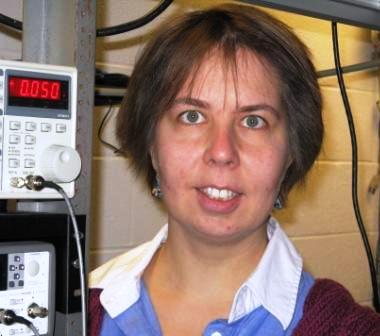 |
Irina Novikova
Telephone: (757) 221-3693
FAX: (757) 221-3540
Office: Millington 249
Address:
Department of Physics
College of William&Mary
P.O. Box 8795
Williamsburg, VA 23187-8795
Research group web-site
http://physics.wm.edu/~inovikova/group.html |
(pdf)
Research description for a Rutile coupling prism in the
development of electrically pumped organic semiconductor thin film lasers.
This description will give a brief insight into our research at the
Light Technology Institute of the University of Karlsruhe (TH), Germany. One of
our research fields is the development of electrically pumped organic
semiconductor thin film lasers. Due to the complex behavior of these lasers
numerous electrical and optical characterization is necessary. One of the most
important optical properties of these organic semiconductor laser structures is
the attenuation coefficient of the multilayer waveguide, which has to be
carefully optimized to reduce waveguide losses 1. The first step in the
optimization process is the numerical simulation of the anticipated waveguide
design. Next, the optimized sample structure is fabricated and characterized in
our attenuation measurement setup. This measurement is done as follows:
A Rutile coupling prism is pressed onto the waveguide. A laser beam is then
coupled into the prism so that total reflection occurs inside the prism at the
interface to the waveguide. In the vicinity of the waveguide the overlapping
incident and reflected beam generate a standing wave. The evanescent field of
that standing wave penetrates into the waveguide.
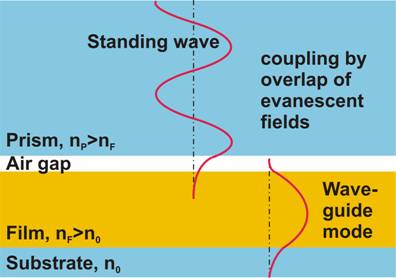
Evanescent field coupling
Under a certain angle and if the phase match conditions are fulfilled, the
evanescent field stimulates a mode that is guided by the waveguide. The phase
match condition can only be achieved when the refractive index of the prism is
at least as high as the effective refractive index of the waveguide. Owing to
its high refractive index, Rutile is an ideal material for use as a coupling
prism in such a prism-coupler waveguide attenuation measurement setup.

Beam coupling into waveguide
A small fraction of the guided light is scattered out of the waveguide. The
intensity of this scattered light is assumed to be proportional to the intensity
of the guided light. Thus the intensity distribution inside the waveguide along
the propagation direction can be directly determined through measuring the
intensity of the scattered light.
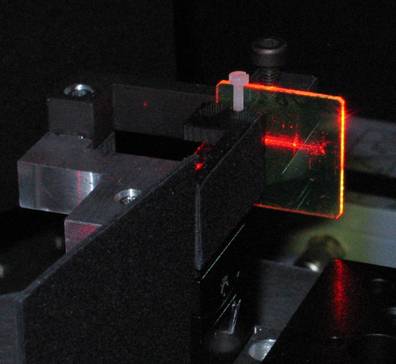
Streak caused by scattering inside the waveguide
The intensity distribution is detected with a computer controlled, cooled CCD-Camera.
Finally the attenuation coefficient is extracted from the measured data.
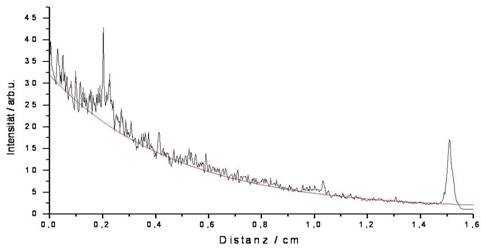
Intensity distribution measured with CCD-Camera
The following two figures show the setup that was used for the measurements.
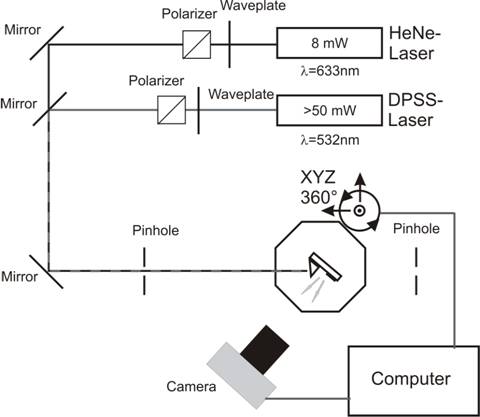
Schematic of the Setup

Photography of the Setup
Additionally, it is possible with our setup to measure the refractive index and
the thickness of waveguides that support a minimum of two guided modes. These
parameters can be extracted from the dependency between coupling angle and
effective refractive index.
Keywords: Prism, Coupling, Thin film waveguide, Waveguide losses, scattering,
Effective refractive index, Organic semiconductor lasers, Polymer, Small
molecule, Evanescent field, CCD-Camera, Coupling angle
1 M. Reufer, J. Feldmann, P. Rudati, A. Ruhl, D. Müller, K. Meerholz, C.
Karnutsch, M. Gerken, and U. Lemmer, Appl. Phys. Lett. 86, 221102 (2005).
(pdf)
 |
MSc.Christian Karnutsch
Lichttechnisches Institut
Universität Karlsruhe (TH)
Geb. 30.34
Kaiserstraße 12
D-76131 Karlsruhe
Raum: 126
Telefon: +49 721 608 7742
Telefax: +49 (0)721 608 - 2590 |
Optical Waveguiding
in Ferroelectric Na0.5K0.5NbO3 Thin Films
Prism coupling as a non
destructive tool for optical characterization of (Al,Ga) nitride compounds
Inter-laboratory
Measurements of the optical losses in Ferroelectric thin films by prism coupling method
rutile Brewster prism
Del Mar Photonics
| Standard Specifications (buy
online): Rutile (TiO2) coupling prism
Material: single crystal TiO2
Sizes: 5x5x5 mm +/- 0.2 mm
Angles:45-45-90 deg.+/-10 arcmin
Polish quality: 20/10Scratch/Dig
Surface flatness: lambda @ 633nm
Parallelism: <5arcmins
Orientation: Z-axis along prism thickness +/- 15 arcmin
|
 |








